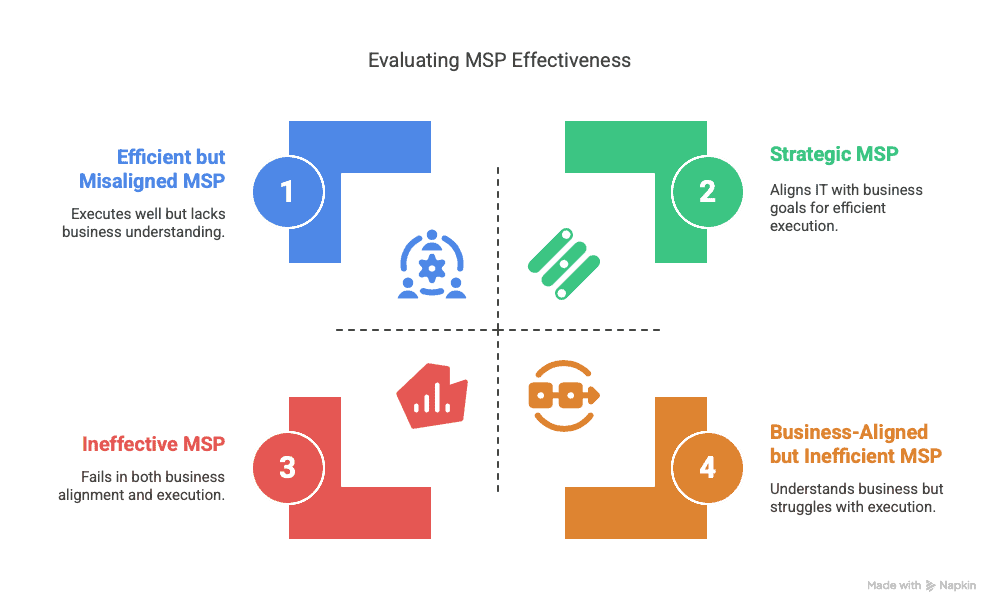
The Architecture of Alignment: How to Choose a Managed Services Provider Built for Your Business DNA
Knowing how to choose a managed services provider is less about due diligence and more about decoding intent. Anyone can deliver tickets and dashboards. Few can embed into the bloodstream of your operations without causing inflammation.
The worst part? Misfit MSPs don’t fail visibly. They quietly erode momentum, waste executive oxygen, and normalize mediocrity. The best ones? You barely notice them, because everything just works.
75% of businesses globally are stuck navigating IT limitations caused by talent shortages. That’s not just a staffing stat – it’s a strategy signal. It means that more companies are outsourcing vital infrastructure without fully understanding who is driving. And it’s why choosing the right MSP isn’t a procurement move. It’s a control mechanism for complexity, risk, and growth velocity.
Chris Butler, executive VP at IP Services, says, “The right MSP doesn’t just plug into your environment – it rewires how your business moves.” This blog unpacks the invisible filters great companies apply when selecting managed service partners.
Not the marketing fluff. Not the slide decks. The real tells – operational empathy, situational fluency, and long-term compatibility. Read on if you’re choosing a partner you plan to scale with, not fire quietly six months in.
How to Choose a Managed Services Provider That Thinks in Outcomes, Not Outputs
The process of knowing how to choose a managed services provider begins with recognizing that support is not the same as strategy. Most providers deliver uptime. Only a few deliver momentum. The best MSPs are measured not by dashboards but by the speed at which internal teams can execute with confidence.
1. Examine Their Understanding of Business Context
An MSP that can’t connect IT execution to business objectives isn’t solving the correct problems.
- Ask how they measure success beyond SLA compliance
- Review case studies for evidence of cross-departmental fluency
- Look for signs they understand your revenue model, not just your tech stack
2. Prioritize Execution Over Promises
Providers should not be chosen for what they plan to deliver. They should be judged on how well they execute under real conditions.
- Examine their onboarding methodology
- Ask for average resolution times across industries, not just verticals
- Review escalation protocols and how they behave under workload pressure
3. Audit Their Service Stack for Relevance
The wrong MSP brings tools. The right one brings clarity.
- Eliminate providers that over-index on legacy systems
- Prefer those who minimize tool redundancy
- Assess how their monitoring and support platforms align with your environment
4. Evaluate Their Influence on Decision Velocity
The hidden value of a strong MSP is not in saved time – it is in faster decisions, with cleaner data and less internal noise.
- Review how reporting is structured
- Ask if business leaders receive insight-ready dashboards
- Clarify who interprets the data and presents the action
Managed services offer 45–65% cost savings compared to internal IT groups. But, cost alone cannot justify the choice. It must be accompanied by leverage, clarity, and an outcome-oriented approach.

Managed Security Services That Scale With Threat, Not Just Tech
Deciding how to choose managed security services should not start with tools. It should start with thresholds. Every organization has a different tolerance for risk, downtime, and disruption. A provider that applies the same stack to every client isn’t managing threats. They’re distributing them.
1. Interrogate Their Security Model, Not Just Their Stack
Good providers talk about firewalls. Great ones talk about what happens after a firewall fails.
- Ask about real-world incident response frameworks
- Review detection timelines alongside recovery windows
- Look for layered models that account for human error, third-party risk, and active threat evolution
The average Spend per Employee in the Managed Services market is projected to reach US$6.87 in 2024. That number indicates how deeply security is now intertwined with operational health. It’s not a bolt-on. It’s a budget line that shapes resilience.
2. Evaluate Response Logic, Not Just Alerts
Security isn’t in the detection. It’s in the decision.
- Who confirms the threat?
- Who contacts the client?
- Who makes the call to isolate, reboot, and escalate?
You’re not just hiring a system. You’re hiring a chain of reactions.
Managed Services Selection Criteria That Separate Capacity from Capability
Every provider claims to scale. Fewer can prove they do it without adding complexity. When evaluating managed services selection criteria, the goal is not to identify how much support a vendor offers – it’s to assess how intelligently that support extends your internal capability.
1. Audit Their Approach to Elasticity
Capacity is about headcount. Capability refers to how well individuals execute tasks across varying conditions.
- Review how quickly they can scale coverage across locations or divisions
- Ask how workloads are rebalanced during staff shortages or demand spikes
- Look for modular contracts that flex with actual need, not arbitrary thresholds
2. Study Their Governance, Not Just Availability
Availability is table stakes. Governance is what shapes sustainable service.
- What are their escalation paths for non-technical issues?
- How is client feedback looped into service refinement?
- Who has the authority to break processes when the situation requires it?
3. Analyze the Depth of Institutional Insight
A scalable provider builds context into the service. Not just access credentials, but operating logic.
- Do they assign dedicated client strategists or rely on pooled support?
- Is service continuity protected during team transitions?
- Can they demonstrate fluency in your industry’s metrics, not just your network layout?
Selection Criteria That Reveal Depth Over Display
| Evaluation Area | What Most MSPs Offer | What Scalable MSPs Actually Demonstrate |
| Support Availability | 24/7 coverage listed on paper | Load-balanced support teams with shift accountability |
| Team Scalability | Access to a larger team on request | Predictive resourcing models tied to usage patterns |
| SLA Structure | Standard SLAs for all clients | Customized SLAs aligned to business-critical functions |
| Onboarding Approach | Initial checklist and system access | Embedded onboarding tied to internal workflows and change readiness |
| Documentation Standards | Ticket notes and config logs | Living documentation mapped to systems, ownership, and context |
MSP Qualifying Questions That Surface Operational Fluency and Cultural Fit
Technology can be standardized. Culture cannot. When it comes to MSP qualifying questions, most evaluations focus on systems, pricing, and availability. What’s often missing is a read on how the provider thinks – how they solve problems, how they behave under stress, and how closely their rhythms match your own.
1. Ask Questions That Challenge Their Default Thinking
Surface-level alignment tells you what they do. More profound questions reveal how they work.
- How do you adapt your service delivery to different management styles?
- What’s your response when a client asks for something outside the contract?
- Can you describe a time you had to unwind your process to protect client outcomes?
Their answers won’t just reveal capability. They’ll reveal their mindset.
2. Use Scenarios, Not Just Service Menus
Real fluency shows when the situation changes.
- Ask how they would handle a high-impact incident without immediate access to your internal team
- Pose a scenario where conflicting priorities emerge between two business units
- Present a resource gap and ask how they’d adjust their delivery model in response
Providers who lean on scripts will freeze. Those who lead with curiosity will navigate.
3. Observe the Interactions, Not Just the Answers
Fit is not always found in words. It’s in how people listen, react, and engage.
- Take note of who speaks most and who listens best
- Ask about team structures and who will lead onboarding
- Watch for signs of humility, urgency, and problem ownership
MSP qualifying questions should uncover more than technical knowledge. They should expose whether the provider thinks like a collaborator or a contractor.
Managed Services Vendor Selection Criteria That Guard Against Strategic Entropy
The wrong vendor doesn’t just underdeliver. It slowly reshapes your operations in ways you didn’t intend. When evaluating managed services vendor selection criteria, leaders must look beyond capabilities to consider other key factors. What matters more is whether the provider becomes a stabilizer or a silent source of fragmentation.
1. Assess Their Influence on Your Operating Structure
Vendors become embedded quickly. The wrong architecture creates long-term overhead.
- Review how they document and transfer knowledge
- Ask how they manage configuration consistency across platforms
- Clarify how they prevent support overlap with internal teams
2. Look for Signs of Long-Term Design Thinking
Short-term coverage is easy. Scalable design takes discipline.
- Do they propose changes that reduce tool sprawl?
- Can they consolidate redundant systems without disrupting workflows?
- How often do they revisit the architecture to reduce friction?
If they never challenge your environment, they’re not improving it.
3. Evaluate Their Impact on Internal Velocity
Strategic fit isn’t about helping your IT team move faster. It’s about helping your business move smarter.
- Do their insights reach department heads or stay buried in tech reports?
- Are they reducing the volume of meetings or increasing it?
- Is their reporting reactive or prescriptive?
The best managed services vendor selection criteria are not technical at all. They’re operational. They measure whether the provider becomes part of your internal logic or part of your workload.
IP Services – Built for Businesses That Think in Systems, Not Just Solutions
We don’t compete on dashboards or tickets. We integrate where others interrupt, align where others react, and design for outcomes that unfold over quarters, not weeks.
Contact us today to rethink what managed services should look like.


